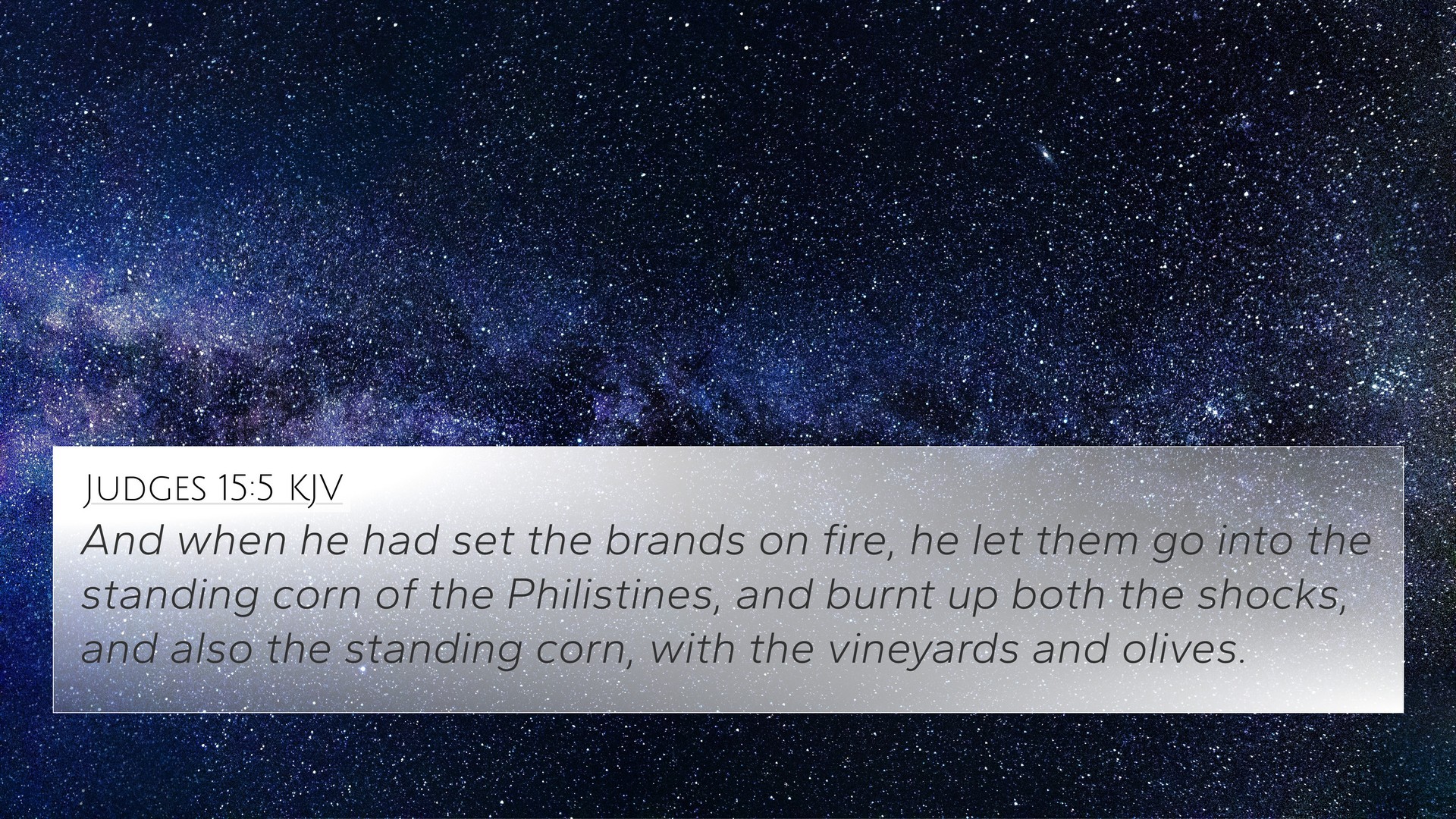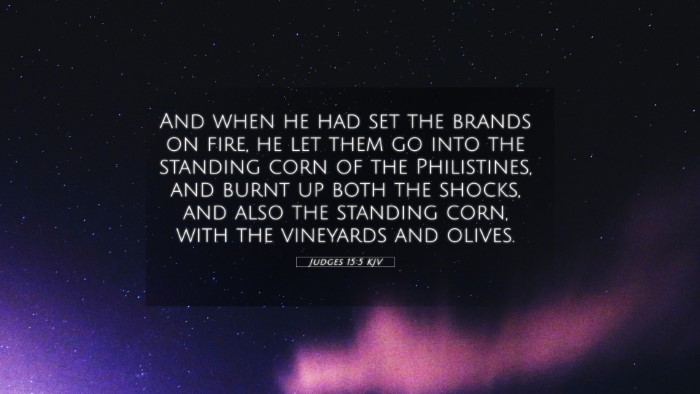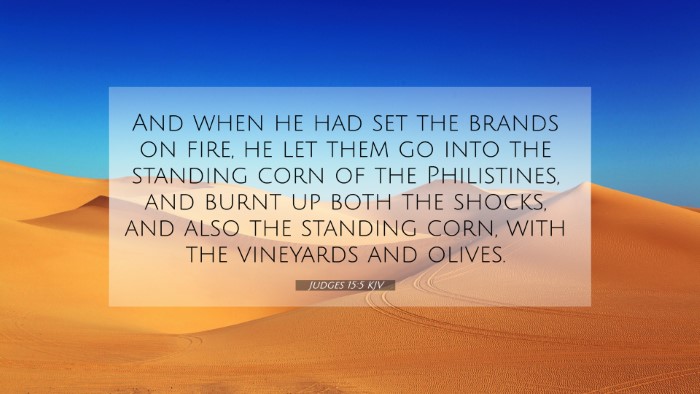Old Testament
Genesis Exodus Leviticus Numbers Deuteronomy Joshua Judges Ruth 1 Samuel 2 Samuel 1 Kings 2 Kings 1 Chronicles 2 Chronicles Ezra Nehemiah Esther Job Psalms Proverbs Ecclesiastes Song of Solomon Isaiah Jeremiah Lamentations Ezekiel Daniel Hosea Joel Amos Obadiah Jonah Micah Nahum Habakkuk Zephaniah Haggai Zechariah MalachiJudges 15:5 Similar Verses
Judges 15:5 Cross References
And when he had set the brands on fire, he let them go into the standing corn of the Philistines, and burnt up both the shocks, and also the standing corn, with the vineyards and olives.
Uncover the Rich Themes and Topics of This Bible Verse
Listed below are the Bible themes associated with Judges 15:5. We invite you to explore each theme to gain deeper insights into the Scriptures.
Judges 15:5 Cross Reference Verses
This section features a detailed cross-reference designed to enrich your understanding of the Scriptures. Below, you will find carefully selected verses that echo the themes and teachings related to Judges 15:5 KJV. Click on any image to explore detailed analyses of related Bible verses and uncover deeper theological insights.
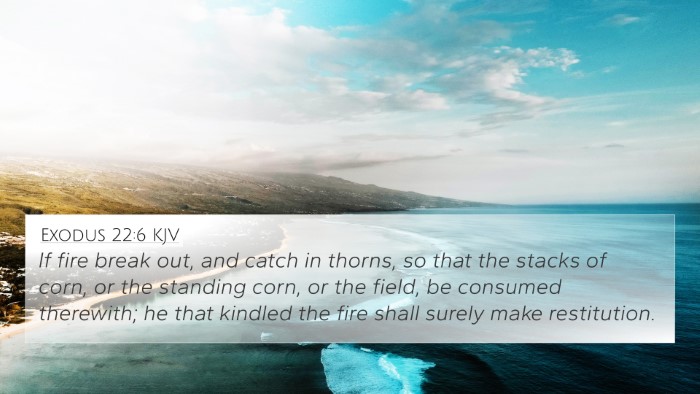
Exodus 22:6 (KJV) »
If fire break out, and catch in thorns, so that the stacks of corn, or the standing corn, or the field, be consumed therewith; he that kindled the fire shall surely make restitution.
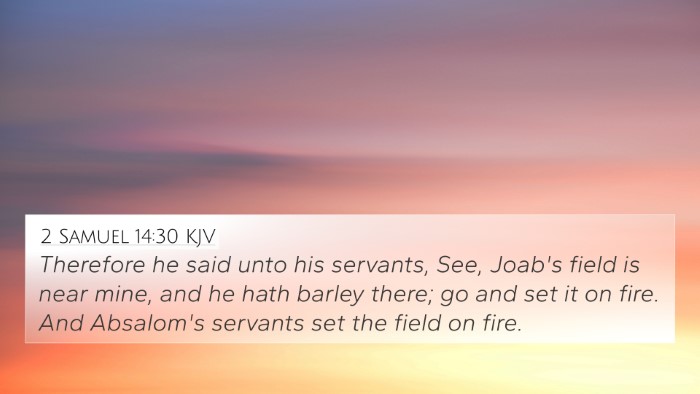
2 Samuel 14:30 (KJV) »
Therefore he said unto his servants, See, Joab's field is near mine, and he hath barley there; go and set it on fire. And Absalom's servants set the field on fire.
Judges 15:5 Verse Analysis and Similar Verses
Understanding Judges 15:5
Judges 15:5 states:
"And when he had set the brands on the foxes, he let them go into the standing corn of the Philistines, and burnt up both the shocks, and also the standing corn, with the vineyards and olives."
This verse captures a pivotal moment in the life of Samson, a judge of Israel, illustrating his conflict with the Philistines. Below, we explore the meaning and implications of this verse using insights from public domain commentaries.
Commentary Insights
Matthew Henry’s Commentary
Matthew Henry highlights the intentionality behind Samson's actions. He suggests that the act of tying firebrands to foxes and releasing them into the fields of the Philistines was a strategic way to inflict damage upon the enemy. This was not merely an act of vengeance but also a demonstration of Samson’s strength and cunning. Henry interprets this as a symbolic act representing God's judgment against the Philistines for their oppression of Israel.
Albert Barnes’ Notes on the Bible
Albert Barnes elaborates on the method and the implications of Samson’s actions. He remarks on the devastation caused by setting fire to the crops, which were vital to the Philistines' economy. Barnes draws connections to the broader theme of divine retribution and the lengths to which Samson would go to protect his people. He emphasizes the destructive nature of war and the consequences that follow, as Samson's guerrilla tactics incite further conflict.
Adam Clarke’s Commentary
Adam Clarke provides a more detailed analysis of the cultural and practical implications of Samson’s methods. He explains how the foxes, typically overlooked in biblical narratives, serve as an unwitting instrument of divine judgment. Clarke points out the historical context of the tension between the Israelites and the Philistines, emphasizing that Samson’s acts were not only personal vendettas but also indicative of a larger historical struggle.
Thematic Connections and Cross-References
This verse serves as a vital link in the narrative of Samson and the ongoing conflict with the Philistines. Here are key thematic cross-references to explore:
- Judges 14:19 - The Spirit of the Lord empowered Samson, showcasing the divine influence in his actions.
- Judges 16:1 - Further acts of Samson that also emphasize his contentious relationship with Philistines.
- Exodus 15:9 - Illustrates the Lord as a warrior against those who oppress Israel.
- 1 Samuel 7:10 - God hears Israel's cries and acts against oppressors, paralleling the narrative in Judges.
- Proverbs 24:17-18 - The idea of not rejoicing when one's enemy falls connects to the moral implications of Samson's actions.
- Romans 12:19 - A contrasting view on vengeance, reflecting on God's role as the ultimate judge.
- Luke 4:18 - Jesus’ proclamation about freeing the oppressed, linking the theme of liberation from bondage.
Tools for Cross-Referencing
For those delving deeper into the Biblical text, various tools can aid in effective cross-referencing:
- Bible Concordance: A resource to locate passages by keywords or themes.
- Bible Cross-Reference Guide: Organizes related verses for thematic studies.
- Cross-Reference Bible Study: A method of studying the Bible through meaningful connections between verses.
Conclusion
Judges 15:5 is a multi-layered verse rich with implications of divine justice and human action. The commentary insights combined with the thematic cross-references illustrate the complex nature of Samson’s struggle against the Philistines. Understanding these connections not only enriches the study of this passage but also enhances our grasp of the overarching biblical narrative.
